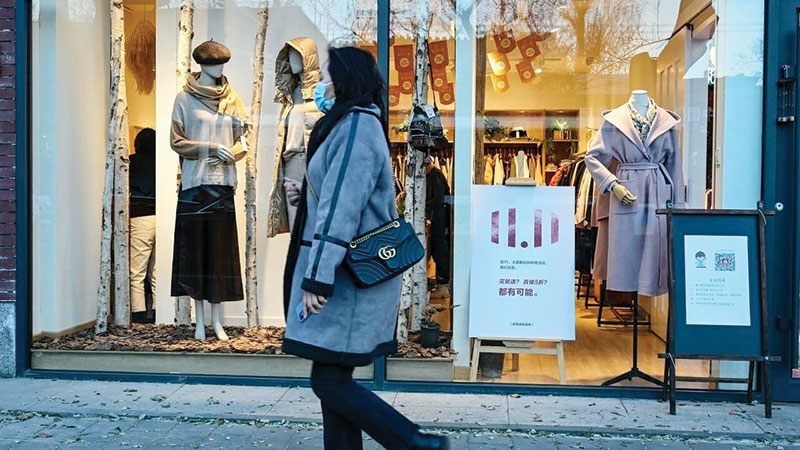ChinaŌĆÖs retail sales growth eases, factory output picks up
 BEIJING: SinglesŌĆÖ Day, the biggest shopping day of the year in China, saw disappointing sales. ŌĆöAFP
BEIJING: SinglesŌĆÖ Day, the biggest shopping day of the year in China, saw disappointing sales. ŌĆöAFPBEIJING: Chinese consumer spending grew at a slower-than-expected pace in November, data released yesterday showed, with analysts warning that an uptick in coronavirus cases was dampening sentiment and adding to questions over a rebound in the worldŌĆÖs second-largest economy.
ChinaŌĆÖs economy bounced back quickly from the pandemic after authorities contained COVID-19 with strict border controls and targeted lockdowns, but the recovery has been losing steam this year. Economists said a current nationwide increase in Chinese coronavirus cases, and resulting containment measures, appear to have led to cautious consumer behavior just as a property market slump worsens.
Retail sales rose 3.9 percent on-year, according to the National Bureau of Statistics (NBS), coming in below expectations and markedly slower than OctoberŌĆÖs 4.9 percent. ŌĆ£The international environment has become more complex and severe, and there are still many constraints on domestic economic recovery,ŌĆØ NBS spokesman Fu Linghui told reporters.
Fu added that ChinaŌĆÖs economy faced the ŌĆ£triple pressuresŌĆØ of shrinking demand, supply shocks and weakening expectations, but that it was still expected to steadily improve. Economists Sheana Yue and Mark Williams of Capital Economics said in a research note that the pandemic ŌĆ£remained the key reason holding back a full recovery,ŌĆØ blaming it for ŌĆ£weakness in the labor market.ŌĆØ
The urban unemployment rate ticked up to five percent last month, from 4.9 percent. Williams had said earlier that recent data indicated that consumers were choosing to travel less as virus cases rise, while warning of other ŌĆ£downbeat signalsŌĆØ such as slowing growth in sales during the annual November 1-11 shopping festival-ChinaŌĆÖs answer to the US ŌĆ£Black FridayŌĆØ consumer spree.
Power crisis fades
NBS spokesman Fu had told reporters previously that ŌĆ£current international environment uncertainties are mounting and the domestic economic recovery is still unstable and uneven.ŌĆØ The economy grew only 0.2 percent from the previous three months in the third quarter, the weakest since a historic contraction in the first quarter last year.
On the positive side, industrial production grew 3.8 percent on-year in November, in line with expectations of a pick-up as disruptions from power shortages eased. Outages in recent months, which were linked to emission reduction targets, surging coal prices and supply shortages, had hit some factory production.
ŌĆ£Even though power supply shortages have eased recently, elevated input prices will linger... and sluggish domestic demand could be a longer-term drag,ŌĆØ MoodyŌĆÖs Analytics warned. Fixed-asset investment growth slowed to 5.2 percent in the first 11 months, with property investment rising six percent-down from the January-October period-amid falling home sales and tight financing rules.
ŌĆ£Wage arrears in property-related sectors, especially the construction sector, could also weigh on consumption,ŌĆØ said Lu Ting, chief China economist at Nomura.
The Chinese property sector has been thrown into uncertainty as major developers such as the giant Evergrande Group struggle to dig out of crushing debt burdens. ChinaŌĆÖs economic growth rate came in below expectations at 4.9 percent in the July-September third quarter on the property sector woes and energy crisis. Policy makers have been grappling with a long-term slowdown in recent years, which follows decades of hyper-fast growth.
Lu said consumer spending was likely to ŌĆ£remain subduedŌĆØ in coming months, including the upcoming Lunar New Year holidays, as authorities in some areas have encouraged consumers to avoid unnecessary travel. The extended holiday period, which falls at the beginning of February next year, is normally an important time for the travel and retail sectors. ŌĆö AFP










